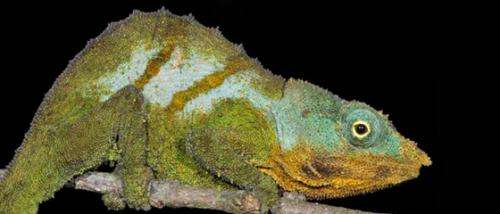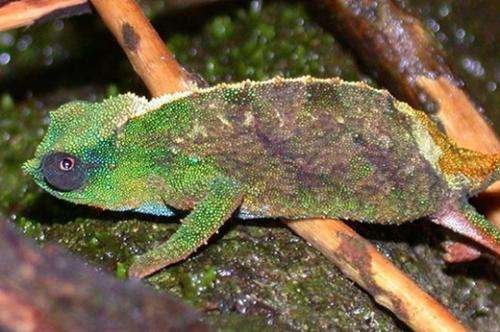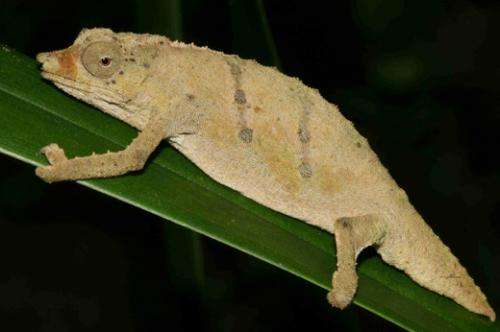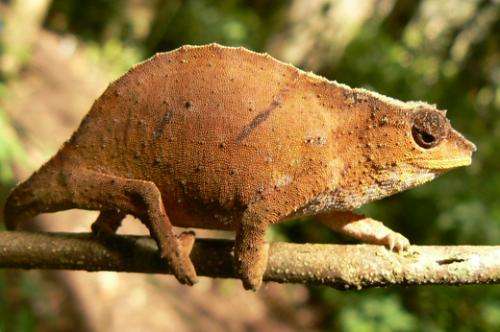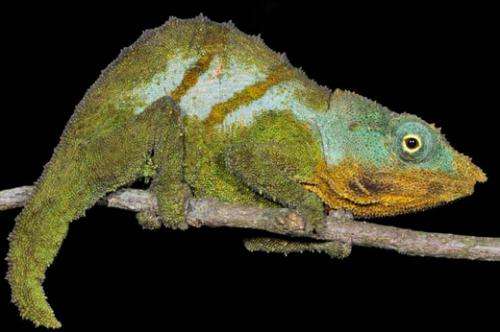Expeditions to northern Mozambique's remote mountains have uncovered a wealth of new species, including four pygmy chameleons.
Researchers have discovered four new pygmy chameleon species in Mozambique, which have now been described and published in the scientific journal Zootaxa.
The chameleons were discovered by researchers who were assessing the plant and animal diversity of Mozambique's 'sky islands' – isolated mountains found in the north of the country.
While similar mountain ecosystems in Africa have been explored in detail, Mozambique's mountains have been largely overlooked. The researchers focused on four mountains: Mt Chiperone, Mt Inago, Mt Mabu and Mt Namuli. As these sites feature isolated pockets of rainforest which have been separated for many thousands of years, the researchers suspected that they may harbour species not found anywhere else.
They were right.
Among many other discoveries, including new snake and butterfly species, each mountain revealed its own unusual chameleon. Further investigation revealed all four to be distinct species, new to science.
Dr Julian Bayliss, a consultant for Fauna & Flora International who organised the expeditions, said: "The biodiversity of the high altitude mountains of northern Mozambique is only starting to be explored and we are finding many new species from most taxonomic groups. This is just the start, and we expect many more new discoveries in the future."
Chameleons uncloaked
It can be rather difficult to tell the difference between chameleon species, as they are often visually quite similar.
To determine whether the pygmy chameleons found in these four mountains were different to known species, scientists therefore had to take detailed measurements and analyse DNA samples.
The DNA analysis, in particular, allowed them piece together the evolutionary history of the four chameleon species, and compare this to known species found in nearby mountains.
Each of the four chameleons was identified as a new species (see below). Although they are believed to share an ancient ancestor, they began to diverge into distinct species between 11 and 20 million years ago.
Four mountains, four chameleons
Rhampholeon nebulauctor. Credit: Julian Bayliss.
Above: The Chiperone pygmy chameleon (Rhampholeon nebulauctor) is fairly small at around 4-6 cm. Its name comes from the Latin for 'cloudmaker', alluding to the cold drizzle that falls over the highlands of southern Malawi as moist air from the Indian Ocean is forced to rise over Mt. Chiperone.
Rhampholeon tilburyi. Credit: Krystal A. Tolley.
Above: The Mount Namuli pygmy chameleon (Rhampholeon tilburyi) is named after renowned chameleon expert Dr Colin Tilbury. This is another relatively small species, at around 4-7 cm. The males tend to be smaller than the females and have a prominent fold of skin on the snout, creating a distinctly 'nose-like' look.
Rhampholeon Bruessoworum. Credit: Julian Bayliss.
Above: The Mount Inago pygmy chameleon (Rhampholeon bruessoworum) is also small at around 5-6 cm. Both males and females have relatively long tails, compared to other related species. It is named after brothers Carl and Darren Bruessow to honour their contributions to the protection of wildlife in southern Malawi.
Rampholeon Maspictus. Credit: William R. Branch.
Above: At around 7-8 cm long, the Mount Mabu pygmy chameleon (Rhampholeon maspictus) is a relatively large species. Its name comes from the Latin for 'painted man', reflecting the striking green, blue and yellow colouration of breeding males.
Nature under threat
The Afromontane Archipelago is a series of mountain chains and inselbergs (isolated mountains) that stretches from Ethiopia to South Africa and encompasses Mozambique's sky islands.
Video courtesy of Google.
Cloaked in forest, grassland and heathland habitats, this mountain archipelago is known to harbour rich biological diversity along its length – so much so that almost every new biodiversity survey seems to reveal new species.
The forest of Mount Mabu is often called the Google forest thanks to its discovery by Dr Julian Bayliss using Google Earth (learn more in the video below), and is thought to be the largest and most intact continuous tract of mid-altitude rainforest remaining in southern Africa.
Like many of the world's rainforests, however, this area is threatened by human activities – particularly encroachment around the edges of the forest, slash and burn agriculture, and bush-meat hunting.
Since 2010, Fauna & Flora International (FFI) has been working with Justiça Ambiental (Friends of the Earth Mozambique), local communities and the provincial government to establish a protected area and ensure that this important forest area is managed sustainably.
Journal information: Zootaxa
Provided by Fauna & Flora International
